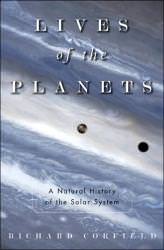It’s no mean feat to translate scientific information into material that’s readily digestible to the average person. The challenge lies in keeping to the facts while making a story worth reading. Richard Corfield in his book Lives of the Planets – A Natural History of the Solar System wonderfully succeeds in making such a translation. In a planet by planet tale, he provides to the reader an engaging review of the information we’ve accumulated.
For the average graduate of our primary schooling system, there’s little unknown about the solar system. Nine planets with some exotically different characteristics revolve about our Sun. But, with a little digging, our solar system gets quite involved. Big moons and small planets, rings galore and volcanic eruptions, life and lifeless are only a few special descriptors that can arise. And, since humanity’s space age got underway, we’ve added a close probe’s-eye view of all the planets and many of the dwarf planets and satellites. Yet, for those who’ve left school, many of these great discoveries have passed by with nary a nod.
Apparently trying to counter this morass of the disinterested, Corfield sweeps through the solar system in a fine literary journey. Using simple but entertaining words, he takes a planet by planet approach. As is common for literary books that encompass the solar system, he begins with a description of the Sun and its relevance to Earth’s early human occupants. For example, he reveals the magic of Stonehenge and the Aubrey stones. Afterwards, his narration expands with humanity’s expanding knowledge. Galileo and his twinkling telescopes quickly give way to the Genesis mission of 2001 that attempted to sample the solar wind. Corfield uses this same historical progression as his chapters progress along from planet to planet. However, though this treatment is typical for books about our solar system, it’s Corfield’s style that makes this one more of a pleasure.
This special style has two components that make this book apt for those who’ve fallen away from science. The first is special tuning toward the human interest, that is, an anthropocentric sense. The lure of finding life, water oceans and other liveable planets arises again and again. Corfield picks away at the perceived uniqueness of humanity, the potential of the solar system and the grand potential of the universe. We may be alone, we may not. Should we go exploring? What value is there from being curious? These and other questions fall to the wayside as the chapters unfold.
The second component welcoming component of this book is Corfield’s style of writing and his choice of words. For example, the Opportunity rover landed ‘smack-bang on the Martian prime meridian’ or ‘the entropy gradient – a pocket of winding-up in a universe that is running down’ brings lots of imagination into the narrative. Added to this are moments for common culture. For example, the crew of the starship Enterprise get mentioned and Corfield provides a sound lambasting of those who laud the lunar landing as a hoax. Yet, it’s this attention to detail that makes this book worthy. For, the reader will readily recall how the book’s passages reflect innumerable twenty second sound bites over the years and, thus, they will come to realize the comprehensive, cohesive picture of science’s progress.
However, blending science into common prose isn’t without its pitfalls. Too much science and too little prose can make the wording stiff. At times, this book reads as if Corfield had a list of facts that just needed to make it into a chapter. These passages come across like a text book rather than a story. Fortunately, these seldom occur. But, to Corfield’s credit, he doesn’t use his stories to mask ignorance. He provides extensive detail about objectives, designs, results and problems so as to easily convince the reader of the accuracy of the book’s contents that’s based upon the breadth of his own knowledge.
Many people today consider space sciences and exploration to be a waste of time and money. Hopefully, there are many more who maintain an open mind and are willing to believe humanity’s future includes more than Earth. These willing to and interested in thinking beyond the day to day will enjoy this book and its synopsis of the natural history of the solar system that humanity’s pieced together.
In a short span of ten thousand years, people have amassed more technical knowledge than any other creature before us on Earth. Though we’ve been looking up and beyond the Earth’s horizon, only within the last few hundred years have we gotten information to satisfy our curiosity. Richard Corfield in his book Lives of the Planets – A Natural History of the Solar System gives the reader an easy to read yet information packed review. With it, the reader can discover that personal knowledge can accrue simply by picking up and reading a book.
Read more reviews or purchase a copy online from Amazon.com.

